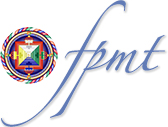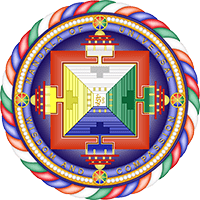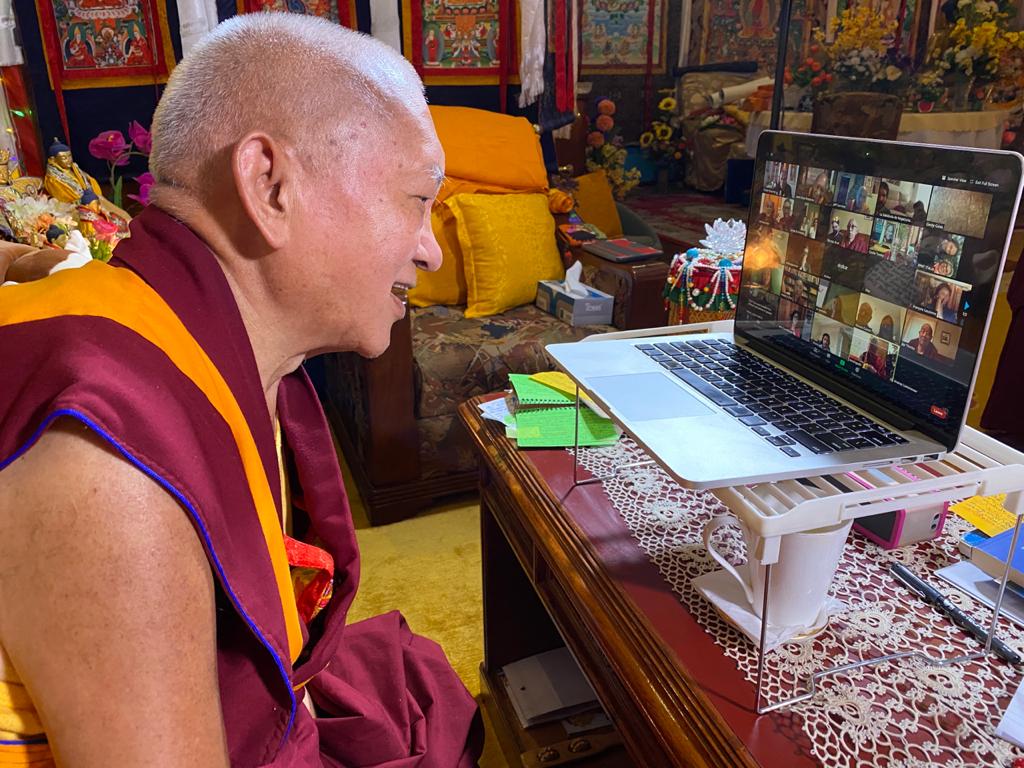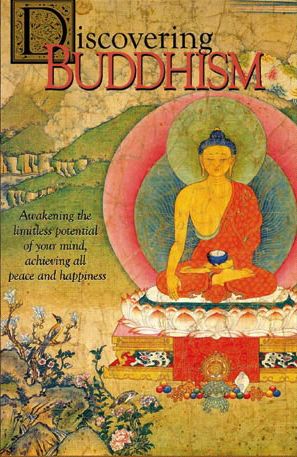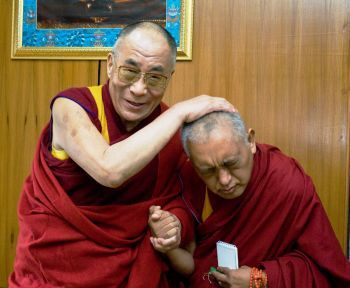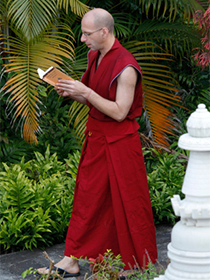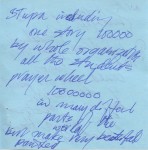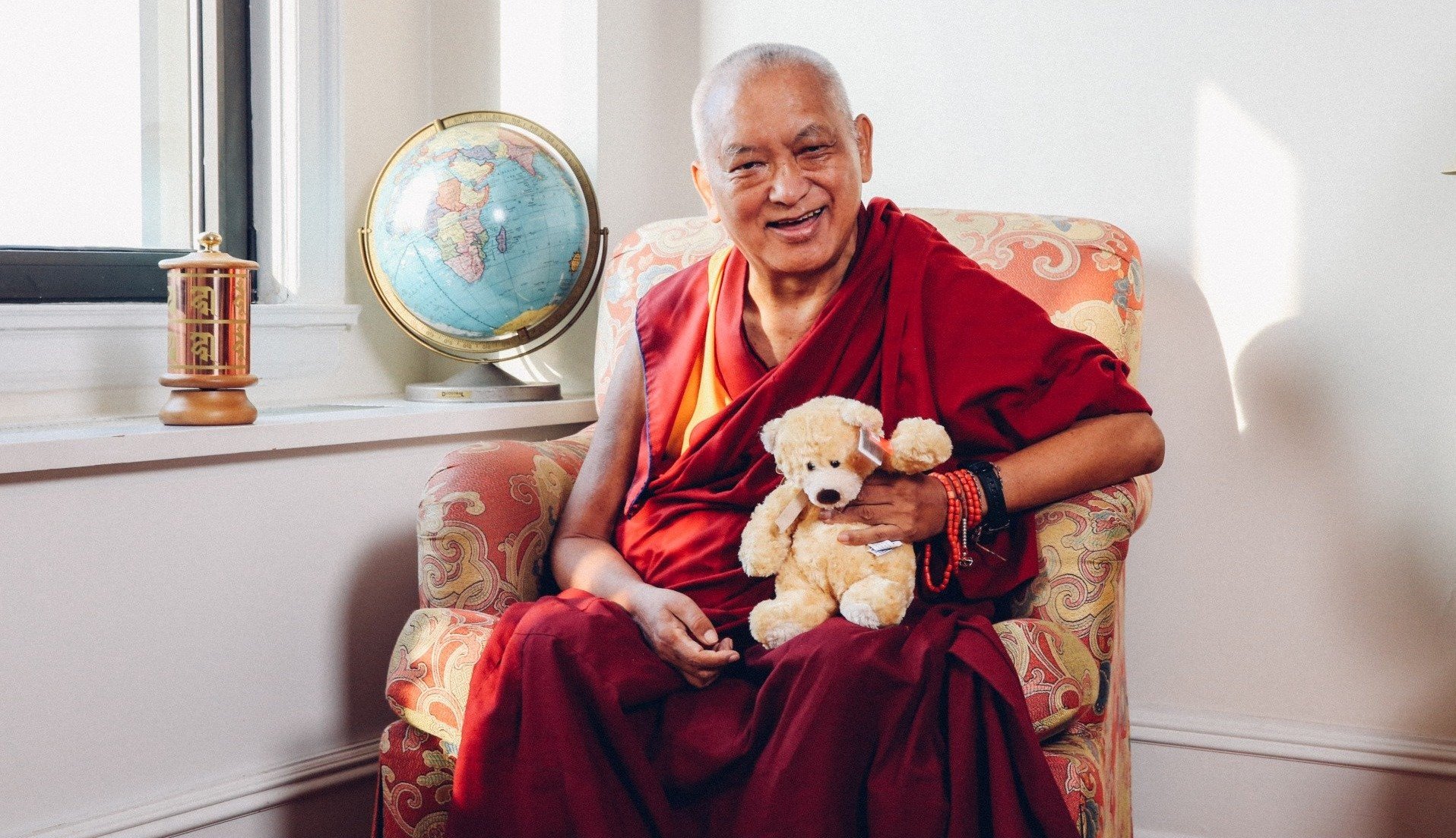
Lama Zopa Rinpoche’s Vast Visions for FPMT
I am just expressing here a general plan for FPMT. There is no limit of time when to complete. I also don’t mean for the centers to do this, I don’t mean to be giving a burden to the centers. We need to have an organizer for each project. We should set this up so it is professional.
—Lama Zopa Rinpoche
Origin of the Vast Visions
In May 2007, Lama Zopa Rinpoche was in retreat at Kachoe Dechen Ling in Northern California. During one morning session, Rinpoche began jotting down some of his ideas and wishes for the future of the FPMT organization onto a stack of small, colored Post-it notes. During the afternoon, Rinpoche explained these ideas to Ven. Roger Kunsang, Rinpoche’s assistant and CEO of FPMT, and Ven. Holly Ansett, assistant to Ven. Roger. These visions from Rinpoche are in addition to what FPMT is already accomplishing due to work of FPMT’s most precious founder, Lama Thubten Yeshe.
The Post-it notes and Rinpoche’s subsequent commentary came to be collectively regarded as the framework for Rinpoche’s long-term “Vast Vision” for FPMT.
You can read Rinpoche’s complete commentary on these visions. At the conclusion, Rinpoche offered a final, “most essential practice.”
Rinpoche’s Vast Visions fall into four general categories:
-
Offering Service to His Holiness the Dalai Lama
-
Holy Objects for World Peace
-
Supporting Practice and Realizations
-
Social Services
Please read details of the Vast Visions below and learn how you can become a part of making them a reality!
Offering Service to His Holiness the Dalai Lama
[I would like] for FPMT to offer service to His Holiness the Dalai Lama as much as possible and to be able to fulfill His Holiness’ wishes. This is the highest priority for the organization.
—Lama Zopa Rinpoche
“We are supporting His Holiness by helping the monasteries, by offering food and all the service to the monasteries, where they do most extensive learning of Buddhism. So this becomes service to His Holiness and to the Tibetan people. The monasteries help to preserve the extensive depth of the Buddhist philosophy on the path to enlightenment. This is a very important service, anything that helps to spread the Buddha’s teachings so it can exist for a long time. This is also what all the centers do, by educating and practicing Tibetan Mahayana Buddhism. This is promoting Tibetan Buddhism, this is service to His Holiness. So anyone who is working in the centers are actually offering service to His Holiness.”
Rinpoche went on to elaborate that he hoped “for the organization to invite His Holiness [to] different parts of the world and to arrange Dharma teachings, initiations, public talks as well as other things that help people in the world, like interfaith meetings, meetings with scientists, with youth, etc.”
“[It would be good] for the centers to arrange regular interfaith dialogues with religious leaders in their local community,” Lama Zopa Rinpoche encouraged.
Please enjoy the below video of the “Spirituality and the Environment” interfaith event with His Holiness in Portland, Oregon, United States, May, 2014, organized in part by FPMT center Maitripa College.
Holy Objects for World Peace
My wish is for FPMT to build many holy objects everywhere, as many as possible. Making it so easy for sentient beings to purify their heavy negative karma and making it so easy for sentient beings to create extensive merit. Which makes it so easy to achieve the realizations of the path and so easy to achieve liberation and enlightenment.
—Lama Zopa Rinpoche
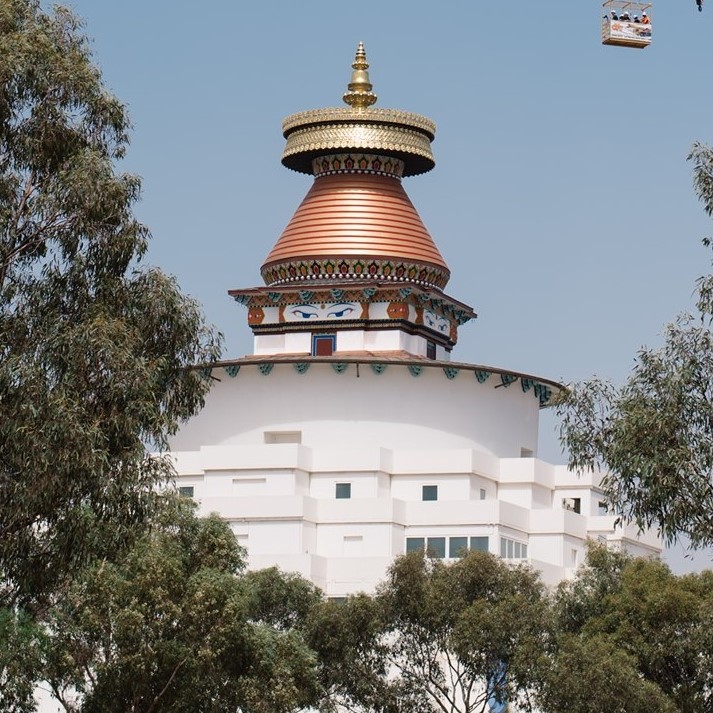
The Great Stupa of Universal Compassion, Bendigo, Australia.
Below are Rinpoche’s visions for the creation of hundreds of thousands of holy objects across the globe.
“Since there is unbelievable benefit, such as liberating sentient beings, then I thought we should aim to build 100,000 stupas (minimum size, one story, up to the distance from the earth to the moon) in different parts of the world and for the organization to do this as a whole,” Rinpoche explained.
“Especially, to build in countries where there are no holy objects and in countries where people have no opportunity to see holy objects. Just by seeing holy objects it purifies the mind and one collects extensive merit. Each stupa must have, as many as possible, the four dharmakaya relic mantras, also 100,000 stainless pinnacle mantras as well as the Namgyälma mantra.
“[I would also like] for the organization to build a 100-foot [30-meter] Kalachakra Stupa, in Amravati, India. I have been thinking about this for some time and recently I checked and it came out very, very good to prevent wars and violence. It came out very good as a method to bring peace in the world.”
Many stupas have been completed, or are in progress, at FPMT centers and by FPMT students toward this goal of 100,000 stupas around the world. One of these stupas is the Great Stupa of Universal Compassion in Bendigo, Australia, which stands 164 feet (50 meters) high.
The Stupa Fund, managed by FPMT Charitable Projects, was established to help fund the creation of stupas that are in accordance with the advice of Lama Zopa Rinpoche.
FPMT Education Services has compiled a resource page providing information about stupas and stupa construction.
“[I would like] for the whole organization to build 100,000 prayer wheels in different parts of the world, [including prayer wheels under the ocean], a minimum height of six feet,” Rinpoche suggested. “Prayer wheels are a great blessing for each country.”
To date, over ten prayer wheels have been completed in accordance with Lama Zopa Rinpoche’s advice. The Prayer Wheel Fund, managed by FPMT Charitable Projects, was established to help fund the creation of prayer wheels
FPMT Education Services has compiled a resource page providing information about prayer wheel and prayer wheel construction.
“My wish is for the big centers in FPMT to have these large thangkas.” Rinpoche explained. “This is a way to leave imprints for all these people [who see them], for enlightenment.”
Many FPMT centers have commissioned large thangkas and are now hosting festival days where these holy objects can be enjoyed. One of these thangkas is a 55-by-40 feet appliquéd thangka of Guru Rinpoche (Padmasambhava) which is displayed during 100,000 Padmasambhava tsog offering in Nepal each year.
We have the following practice texts for use at the large thangka festival days:
- Amitabha Festival Book: Extensive Benefits from Now up to Enlightenment (Peerless Happiness), Including Liberation from Saṃsāra (Definite Happiness) This text is in relation to Amitabha Buddha but it can be used as a basis for another deity by replacing the praises and prayers of Amitabha with those of the deity.
- 1000 Offerings to the Victorious One Invincible Savior, Maitreya: An Abbreviated Offering Ritual
- 1000 Offerings to Lama Tsong Khapa
“Building Guru Rinpoche statues will bring immeasurable benefit, peace, happiness, and freedom to the world. They will have immeasurable impact,” Rinpoche added.
FPMT Charitable Project’s Padmasambhava Project for Peace is dedicated to fulfilling Lama Zopa Rinpoche’s goal of building many large statues of Padmasambhava around the world in order to create the cause for peace for all beings. To date, about twenty statues have been built, one measuring 70 feet (21 meters) high.
Rinpoche also wanted the FPMT organization “to build 1,000 Maitreya statues (the minimum size should be 6 feet).“
“Within the 1,000 statues, this includes the Maitreya statues being built in Kushinagar and Bodhgaya, India. My aim is that the large statue in Kushinagar will last a minimum of 1,000 years. That means that for every day for at least 1,000 years, infinite sentient beings will receive unbelievable benefit and the causes for enlightenment.”
“Another special thing about contributing to Maitreya, whether it be money or time or energy, is that it makes a connection with Maitreya Buddha, and the result is that one becomes a direct disciple of Maitreya Buddha when Maitreya returns to manifest enlightenment as Shakyamuni Buddha did.”
The Maitreya Projects were established to build two magnificent Maitreya statues in Bodhgaya and Kushinagar, India. The Maitreya Project also built two 24-foot Maitreya statues. One is now at Land of Medicine Buddha in California and one is on Maitreya Project land in Bodhgaya. Additionally approximately 100 life size Maitreya statues were created, of which Lama Zopa Rinpoche sponsored and offered 26 to FPMT centers.
The Holy Objects Fund provides the resources to create holy objects around the world for the benefit of all beings and for world peace.
Supporting Practice and Realizations
Anybody who dedicates their life to achieving lam-rim realizations with the goal to liberate numberless beings from the oceans of samsaric suffering and to bring to enlightenment, this is what I regard as the most important thing in the world.

Seventh 100 Million Mani Retreat at Idgaa Choizinling Monastery in Ulaanbaatar, Mongolia, September 2019. Photo by Ianzhina Bartanova.
Below are Rinpoche’s Vast Visions for supporting deep Dharma practice and fostering realizations around the world.
“[I would like] for the organization to support the older students who have worked so hard for the organization, who sacrificed their lives for the organization for 25 years or more, or also for people who have offered 20 or 15 years. Those who need help for treatment or means for living,” Rinpoche said.
“Need to think about how to help them, so they get something back from the organization. First start with the Sangha then the lay people, it also depends on how much funds we have.”
The Lama Yeshe Sangha Fund, managed by FPMT International Office, was established to take care of the International Mahayana Institute, FPMT’s monastic community, by ensuring that the Sangha are educated in vinaya and Buddhist philosophy; have appropriate accommodation; have proper food and nourishment; have access to proper medical care; have a supportive environment and conditions for retreat; and are cared for when sick and elderly.
Lama Zopa Rinpoche commented, “[I would like the organization to continue] establishing good quality monasteries and nunneries, with good quality Sangha in order to preserve the Dharma by having people practicing vinaya. [I would like the organization] to provide support to the FPMT Sangha and the monasteries and nunneries.”
Thirteen of FPMT’s centers have established monastic communities including the organization’s first, Kopan Monastery.
Supporting Sangha is a high priority for FPMT and for over 40 years the organization has been offering support to monasteries in Nepal, India, Mongolia and the West.
The Supporting Ordained Sangha Fund offers support to nunneries and monasteries, and individual monks and nuns around the world for food, accommodation, health care, education and practice. The fund is not limited to any one institution and able to benefit many nunneries, monasteries and Sangha in need.
“[I would like] for the organization to support the older students who worked hard for the organization, who sacrificed their lives to the organization,” Rinpoche affirmed. “And to support those who need help for medical treatment or means for living. We need to think about how to help them so they get something back from the organization. The plan would be to help them for the rest of their life. If there are a lot of funds then we can give some money like a retirement pension. Maybe we could offer the coffin for free (joke). First start with the Sangha, then the lay people, depending on how much funds we have.”
“[I would like] for the organization to establish 100,000 recitations of 100 million OM MANI PADME HUMs.
“It would be very good if the retreats are sponsored by the organization,” Lama Zopa Rinpoche stated. “The idea is for it to be sponsored so people do not have to pay. Also, if an individual person is doing 100 million manis, then for the organization to sponsor the person.”
There are now annual 100 million mani retreats at Tashi Chime Gatsal Nunnery in Nepal, and in FPMT Center in Mongolia and a virtual ongoing 100 million mani retreat at Chenrezig Institute, Australia.
“[It would be good for FPMT] to sponsor people who make a serious commitment in this life to practice such as doing 1,000 nyung näs. People who have completed 1,000 Nyung Näs in their life should have a special title, something to do with Chenrezig.
“Main thing is for the Nyung Näs be sponsored by the organization. The idea is to start as a project and then for the whole organization to sponsor, or to sponsor the food or lodging.”
About Nyung Näs, Rinpoche taught: “This is your best offering, best service to sentient beings; this is how you collect most extensive merit. Doing all those practices, prostrations it is unbelievable purification, by reciting the 35 buddhas, Chenrezig meditation, recitation, by making offerings to Chenrezig you collect the same amount of merit as having made offerings to all the buddhas, and then by taking the eight Mahayana precepts on top, wow! Amazing, gorgeous! So you create limitless skies of merit then by taking them with bodhichitta motivation, it is unbelievable, unbelievable, unbelievable purification, and you can achieve all the qualities of Buddha. It is just amazing.”
The Practice and Retreat Fund provides grants and sponsorships to students engaged in retreats such as 108 Nyung Nä retreats, 100 million mani retreats, recitations of sutras, and long-term retreat and to develop retreat centers.
Lama Zopa Rinpoche advised that “the most beneficial thing to have peace and to stop the wars is reciting the Sutra of Golden Light. This is the most beneficial thing to bring peace, everyone should try to do this, no matter how busy they are, even to recite one or two pages, even a few lines. It is extremely powerful and fulfills all one’s wishes, as well as brings peace and happiness for all sentient beings, up to enlightenment. It is also extremely powerful for one’s own protection and for the protection of the country and the world. [It would be good for FPMT] to sponsor people to go to countries experiencing war or disasters and read this sutra.”
Lama Zopa Rinpoche had also made a personal vow to preserve and propagate this sutra and it is his vision to translate all three versions of the sutra from Tibetan, making them available in as many languages as possible.
FPMT International Office has created a resource page to help you learn more about and start reciting the Sutra of Golden Light (21-Chapter edition). You can download the sutra in 12 languages, report completed recitations, share your experiences, and ask questions about the text itself.
“We need to have more retreat places to study the path,” Rinpoche remarked. “[FPMT] should have many around the world, so it is easy for people and they don’t have to travel very far, and have full knowledge of how to build them, how to make them as perfect as possible for meditation.”
FPMT has many facilities conducive to long-term retreat such as Buddha Amitabha Pure Land in Washington, United States. Rinpoche recently gave specific advice about his plans for this vision:
“So, I am planning to put together this group of people to meditate and gain realizations and this is what is needed for the FPMT organization to develop for the benefit of sentient beings. It is a very, very, very important project because the extensive study of philosophy is something that is already being done in the FPMT, however, meditating and actualizing the lam-rim in retreat, that is something else. We really need the lam-rim realizations in the heart. It’s not easy to attain shiné, even for those who completely dedicate their lives to this.
“We will organize a retreat place for people who want to completely sacrifice their lives to actualize the lam-rim realizations and also shiné. Khadro-la [Rangjung Neljorma Khadro Namsel Drönme] says Washington State in the United States would be best, so I’m thinking to build a few rooms and start there. “
“[I would like] the organization to provide scholarships for students to study,” Lama Zopa Rinpoche exhorted. “Buddhist philosophy based on the lam-rim and lojong: academic studies with practice experience. We need teachers who are not just teaching from texts, but teaching from some experience, then there is so much more benefit. By teaching from one’s experience it brings deeper benefit. Then there is change and transformation of the mind.”
The Education and Preservation Fund supports Dharma study and contributes to the development of Buddhist education programs and the preservation of the Dharma through the publication of Dharma practice materials and translations.
Social Services
[It is good for FPMT] to benefit extensively other sentient beings by offering various social services, such as those that bring loving kindness and peace to youth using Universal Education methods, religious interfaith activities which bring peace and happiness and extensively benefit others by spreading Dharma.
—Lama Zopa Rinpoche

Residents of Dhondenling Old Age Home, Kollegal, India.
Rinpoche’s Vast Visions for social service include supporting a variety of secular education and healthcare programs, and benefiting animals.
“[I would like] for the organization to develop Universal Education more and similar programs in order to develop better human beings, to have more beneficial lives, to bring peace and happiness in the world, to not become harmful to oneself and others,” Rinpoche shared.
Universal Education (for Compassion and Wisdom) is an educational project of FPMT that offers a system of inner learning that enables children, young people and adults to lead a happy and meaningful life and to be of service to others.
“[I would like the organization] to develop different techniques rooted in Dharma for healing, to
help others,” Rinpoche said. “So in this way, we are making other lives much easier and happier.”
A number of FPMT centers offer healing programs for terminally ill people and eight FPMT centers are now offering hospice programs to those in their final days of life including Karuna Hospice.
“[FPMT should] help young people through meditation and consultation, and also help them offer volunteer service as part of their practice.” Rinpoche said. “This brings immediate benefit, so we don’t have to wait for many years, something immediate that you can offer to others.”
There have been many initiatives aimed at benefiting young people including Tara Redwood School, Creating Compassionate Cultures, and other children programs at FPMT centers.
[I would like to have] a program to educate the parents so they can have a good plan on how to bring up children,” Rinpoche added. “We can make a guidebook for parents and also organize and give lectures for parents. Also, I think this is a means for world peace: as His Holiness the Dalai Lama says, the future world depends on young children now – so if you have children with good qualities, with basic education in being a good human being, if parents bring up children with these qualities, then the future world would have more peace.
“So the parents themselves have to be educated before they try with their children. So they need a clear plan. Not just to make children out of attachment, for their own comfort, for their own needs and desire. Like keeping a pet. If it is like this then later they will suffer so much, especially the children will disappoint them, like when they try alcohol or engage in killing, stealing, etc. Then the parents will suffer. It becomes like hell and then so many years that they sacrificed their life for their children, it will become a disappointment and meaningless, and also because all of it was done with attachment and non-virtuous thought – so it becomes negative karma. Because it was not done with a sincere heart, the pure mind, loving-kindness.”
Lama Zopa Rinpoche has given extensive advice about children and parenting.
“Then, [I would like FPMT to offer] social services to help the elderly.”
Many FPMT centers host programs for elderly members including Amitabha Buddhist Center in Singapore, Kurukulla Center in Boston and Land of Medicine Buddha in California.
The Social Services Fund focuses efforts primarily in India, Nepal, Tibet and Mongolia. Funds help children, the elderly, sick, and very poor through grants for schools, hospices, health clinics, soup kitchens, elderly homes, orphanages and more.
“[I would like] for the organization to arrange talks with many religious leaders in the world,” Rinpoche asked. “The plan is to have this as a reoccurring event. So this is the big way. Then to do this in a small way for the centers to do this with religious leaders in their local community. The more that other religious people come to know about His Holiness and understand more and more, it is so effective and in this way it can help for world peace. In this way the organization becomes a tool for world peace.”
“As much as possible [I would like] for there to be animal blessing events when I visit the centers, ” Lama Zopa Rinpoche said. “The animal blessings can be in public places and children can come and other people who are interested, those who don’t come to the center much. There needs to be one table that is piled high with holy objects, mantras recited and then blown on water, then the blessed water can be sprinkled over the animals. There needs to be good advertising so more people come.”
Taking care of all sentient beings, including insects and animals, is a high priority for Lama Zopa Rinpoche and as such FPMT has a number of animal projects including the Animal Liberation Fund, Animal Liberation Sanctuary and MAITRI Charitable Trust. Many centers host regular animal blessings in parks and public places.
In addition to the weekly animal liberations offered by the Sangha at Kachoe Dechen Ling, Lama Zopa Rinpoche has requested the Sangha to also make weekly trips to the Pacific Ocean in order to bless all the beings living in the ocean, by using large Namgyälma mantra boards. Rinpoche also designed animal liberation tools that can be used to catch and benefit small creatures.
As an incredible example of the work being done for animals around the world, Amitabha Buddhist Centre and Ven. Tenzin Drachom have liberated over 200 million animals to date!
The Most Essential Practice
The conclusion is for all the people to practice the lam-rim, which is the heart of Dharma. Especially to try to put all the effort to live with bodhichitta motivation, in particular to have kindness to others, which is the most essential practice. Aiming to have the realization bodhichitta as our main goal, of course based on guru devotion.
—Lama Zopa Rinpoche
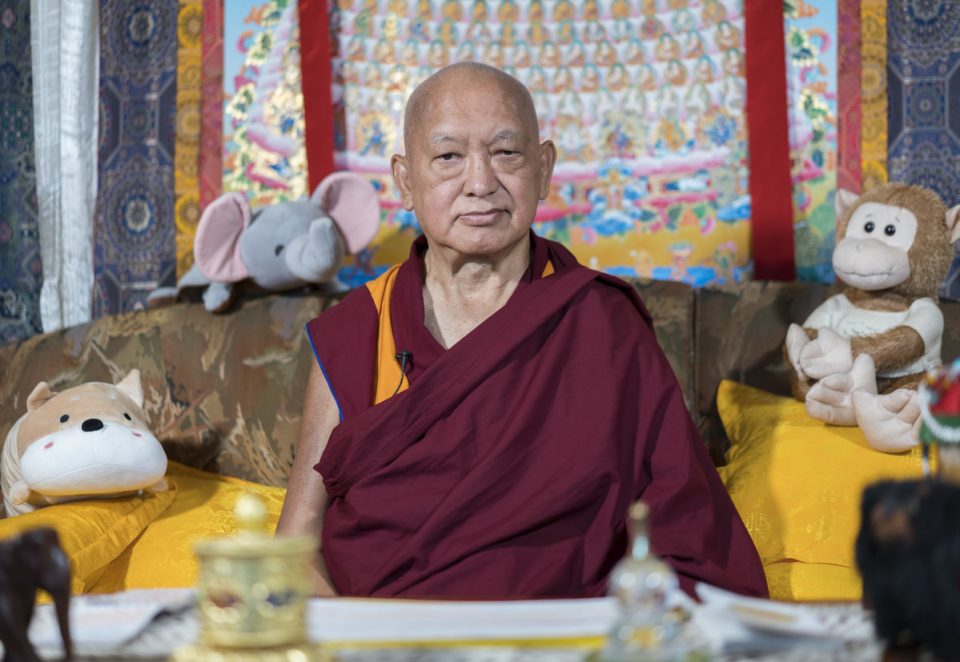
Rinpoche with some friends at Kopan Monastery, Nepal.
Are You Inspired to Be Part of Lama Zopa Rinpoche’s Vast Visions?
As Rinpoche mentioned, the Vast Visions are ambitious and may take many lifetimes to actualize. They also are still evolving and being clarified. Tremendous thanks and gratitude to all who have helped to begin to actualize Rinpoche’s Vast Visions for the FPMT organization.
To take part in one of the Vast Visions, please explore the various projects which have been established to support some of these visions. Supporting these projects helps actualize Rinpoche’s wishes, and as Rinpoche commented, many people getting involved at a smaller level makes large projects possible.
Lama Yeshe: The Origins of FPMT
Why have we established the FPMT? Why are we establishing these facilities all over the world? I think we are clean clear as to our aim – we want to lead sentient beings to higher education. We are an organization that gives people the chance to receive higher education. We offer people what we have: the combined knowledge of Buddha’s teachings and the modern way of life. Our purpose is to share our experiences of this.
—Lama Thubten Yeshe, 1983
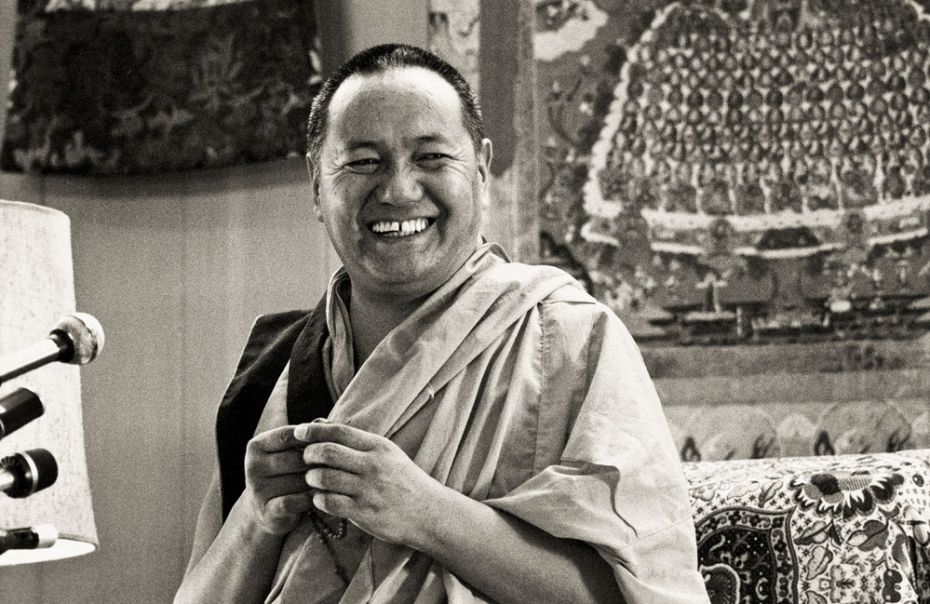
Lama Yeshe, Yucca Valley, California, US, 1977. Photo courtesy of Lama Yeshe Wisdom Archive.
Read more from Lama Yeshe about the origins of FPMT
Learn more about specific Vast Visions at the FPMT Charitable Projects Homepage
